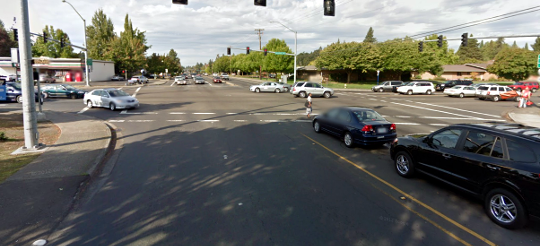
(Image: Google Street View.)
In 2002, looking for future bottlenecks in its road system, the City of Beaverton was troubled by traffic projections for the corner of Southwest Farmington and Murray, one mile west of its historic downtown.
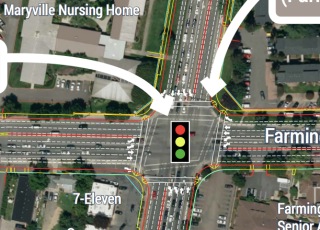
intersections and proximity of a nursing home.)
By 2020, traffic engineers calculated, the number of cars using Farmington would soar from 27,000 cars per day to 36,000, clogging traffic unless the five-lane intersection there — which hosts a 7-Eleven, an apartment complex, a senior living facility and a nursing home — were widened to seven traffic lanes. But after unsuccessfully casting about for years to find money for their “Farmington Road Improvement Project,” the city mothballed it.
Then a funny thing happened: nothing. There was no permanent traffic jam. Eleven years and two business cycles later, Farmington actually carries 700 fewer cars per day.
The seven-lane intersection, however, is back from the dead. The project, which also includes a new center lane further east on Farmington, newly striped bike lanes, a segment of sidewalk and a new signal and realignment of 142nd Avenue, is on track to be paid for by $21 million in Washington County property taxes.
Traffic engineers are still predicting (PDF) that traffic on Farmington is about to balloon: this time to 34,800 by 2035.
In a time when Portland-area residents frequently engage in hot debates over bicycling and walking improvements, this project is a reminder of the vast sums being spent in the region every day to speed up and increase the volume of automobile traffic at the expense of other modes and livability goals.
Literally.
“Mostly I see it as a lost opportunity for the community,” said Peter Welte, who lives three miles southwest of the site in Aloha. “They’re trying to make it faster to get from point A to point B, and in the process not making point B a place that you want to be.”
“They’re trying to make it faster to get from point A to point B, and in the process not making point B a place that you want to be.”
— Peter Welte, local resident
Abe Turki, the project manager, disagreed. “This is more than a $21 million turn lane project,” he wrote Thursday. “I believe it’s a balanced project that will add needed improvements to existing infrastructure.”
He noted that in addition to a continuous painted bike lane on Farmington, it’ll add street lighting and plant street trees to replace some of the ones the project will destroy nearby. The city will also make utility improvements, which are funded separately.
“This is an arterial road and a truck route, so it’s good for movement of vehicles and goods,” Turki said in an interview Thursday. “I think from the bike’s perspective, we’re adding two lanes that are not existing now.”
Welte, who said he often rides his own bike through the area, disagreed.
“For the type of rider that’s comfortable busting up to 30 mph and crossing a few lanes of car traffic to get to the turn lane, that’s fine,” Welte said Thursday. But though he said he can do it, he certainly doesn’t like to.
To prove the point, Welte, who sits on the Community Advisory Committee for Washington County’s Transportation System Plan update, has used what he says is the Federal Highway Administration’s official formula to calculate bicycle safety both before and after the project. Though the bike lane improves things somewhat, the extra lane change for bikes turning left off of Farmington eliminates that benefit.
“Really we’re just getting bike lanes because they have to, legally,” Welte said. As for the new sidewalk on the south side of Farmington, Welte (who also serves on the board of Oregon Walks) noted that the street already has an unfinished street-level path that’s used for walking and biking.
In 2008, 15-year-old Austin Miller was killed on the northwest corner of this intersection after he entered the Farmington roadway against a pedestrian signal after riding his bike south on the Murray sidewalk. At the time, BikePortland readers called this “a very scary place for cyclists.”
According to a recent traffic assessment, 15 percent of drivers on Farmington are already moving faster than 39 mph. The posted speed limit is 35 mph.
Turki, the project manager, said there’s “some truth” to the criticism that the previous traffic projections were wrong.
“The anticipated growth did not happen,” he said. “So the current study came up with lower numbers and we actually ended up adjusting the width of the intersection of Murray and Farmington to reflect those new numbers.”
“It’s not my specialty myself; I depend on traffic engineers and planners to get me those numbers,” Turki said.
For Welte, the problem is that city and county leaders aren’t asking the right questions of their staff and consultants.
“What they’re not doing is looking at all this empty space to the north of the project that’s sort of underutilized land between the project and TV Highway that might have some potential,” Welte said. “In other places, if you said, ‘We have $21 million to improve our community,’ they might think about how our transportation facilities could provide some kind of economic revitalization to nearby destinations.” Instead, Welte laments, he feels the County’s Major Streets Transportation Improvement Program (MSTIP, where the Farmington Road project comes from) focuses too much on widening roads and doesn’t consider how those projects may or may not support nearby small businesses.
Turki said the project had been discussed at “at least 11 meetings” of public outreach and planning back in 2001 to 2003 (PDF) that touched on issues including bike lanes, and that “the bike community” had been represented. The county says it’s not necessary to repeat that process, so the project is now in its final design phase. The next open house on the project is scheduled for January.



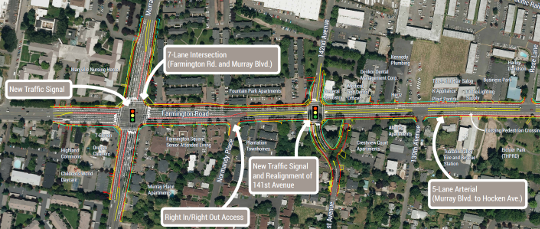

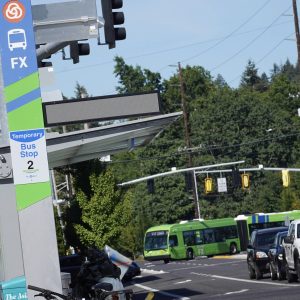
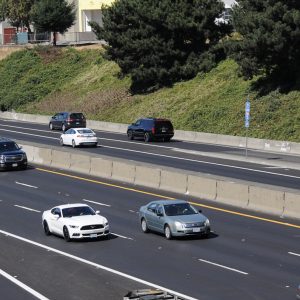
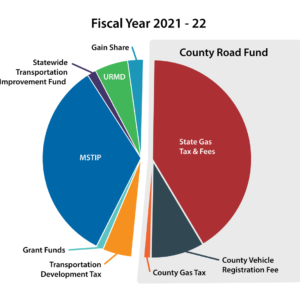
Thanks for reading.
BikePortland has served this community with independent community journalism since 2005. We rely on subscriptions from readers like you to survive. Your financial support is vital in keeping this valuable resource alive and well.
Please subscribe today to strengthen and expand our work.
A couple of salient points that I noticed:
1) “paid for by $21 million in Washington County property taxes.” As a Wash Co home owner, I wish this were printed in bold, all caps, in any story or announcement regarding this project. I’m so tired of being told I don’t pay for my infrastructure.
2) The bike improvements will be included in what looks like a 3ish block long section of roadway. This is completely in line with Beaverton improvements to bike/ped transportation. Wonderful facilities that begin at some random place, with no way to get on them, and then disappear into thin air. I personally love riding along a beautiful stretch of bike lane and then magically being beamed by Scotty to my final destination as the lane abruptly ends into 45mph auto traffic.
I think it’s especially important to highlight the source of funds. Especially following the half-truths provided by The Oregonian and ODOT in response to BTA’s campaign on fund-education.
Here they state that only $17 million in ODOT revenue (less than 0.5% of revenue) comes from the general fund:
http://www.oregonlive.com/commuting/index.ssf/2013/11/portland_bicycle_groups_who_pa.html
Joseph Rose neglects to mention that ODOT is not the only group spending money on roads. Shady journalism or incompetence?
Both, with the sole goal of stirring the pot and getting more hits and comments. His “articles” are worse than worthless.
10 years ago, there was no NACTO Urban Bikeway Design Guide, and a 5 ft bike lane might have been something to celebrate.
But today, we *know* that 5 ft bike lanes are inadequate, and that the answer to making bicycling good is wide 8 ft bike lanes, vertical/physical separation from traffic and safe accommodation at intersections with bike signals and turn boxes.
This $21 million project is Washington County’s chance to do it right. They are rebuilding the road from scratch, and they are putting in a bike lane that is already obsolete.
If Washington County is so worried about traffic congestion, they could use that money to coordinate traffic lights, rather than widening a road that doesn’t need to be widened. All of the major thoroughfares would work much more smoothly if the lights weren’t triggered by cars on the side streets, so that it’s almost impossible to avoid stopping at every single intersection. They’ve got the tail wagging the dog. Widening a street won’t matter when hundreds of cars have to stop at every light for the one or two waiting on a side street.
The signals are already coordinated to at least 149th. Whether the coordinated operations could be improved is a good question. The half mile between Murray and Hocken signals makes it difficult to get good progression because platoon speeds can vary a lot over that distance. Based on the speed survey noted in the article it is likely folks are driving too fast and getting to the next signal before the green band.
A modern roundabout, 2 lanes, can handle up to about 60,000 entering vehicles per day. Slip lanes can increase that number. They’re also safer intersections than signals and have less delay. Considering what’s being proposed, a two-lane modern roundbout would probably use less space and cost less as well.
The FHWA has a youtube video if anyone is interested. I’m unable to paste into the comment box.
This one? http://www.youtube.com/watch?v=GeVWPvRFDi4
UK experience is that roundabouts are considerably more dangerous than signal controlled junctions (by a factor of about 10 IIRC) Many of the larger ones are being replaced by signalled junctions or are now being signal (sic) controlled
Excellent work Michael! Joseph Rose could learn a lot from you.
“I believe it’s a balanced project that will add needed improvements to existing infrastructure.”
“The anticipated growth did not happen, [s]o the current study came up with lower numbers…”
= carhead.
Welte’s right. Turki, et al. really don’t get it.
Maybe, just maybe, we can one day get these bums to throw out the stupid Cold War formulas by which future growth in car traffic is always and invariably predicted. I’m not holding my breath, though.
Michael should replace Rose at the O.
I appreciate it, but god forbid! 🙂 Joe and I have had our differences and will probably continue to, but I think he’s got a tough job that I wouldn’t want and that in general he does well.
What kind of dimwit looks at those traffic numbers and thinks ‘we need more lanes!’
Wow, where have we seen this before? Engineers inflating traffic projections in order to justify their own existence; it’s like pulling a rabbit out of a hat every time…
same tax increase different global warming
yawn . . .
Further north on Murray and Cornell, they spent probably the same amount of money widening the intersection there, adding a bike lane that became useless because the right-turning traffic would regularly back up across it. End result: more traffic jams AFTER project completion than before, and the Humdinger burger joint was demolished to make room for all that extra asphalt. Thanks, geniuses!
Murray-Farmington is a big, ugly intersection…that’s for sure. Lousy for biking. I haven’t yet looked at the pdf’s for how proposed changes to the intersection may or may not improve conditions for biking through it. Wonderful if that were somehow accomplished.
Either Murray or Farmington would be prime candidates for a spacious, grade separated ‘cycle-track’, if the right of way existed or would be secured. Farmington further west of course, is accompanied by a late 70’s curb separated bike lane/MUP directly adjoining the road, which is not particularly good; too narrow, conflicting uses, etc.
I wish Pete Welte’s comment here:
“They’re trying to make it faster to get from point A to point B, and in the process not making point B a place that you want to be.”
… would have been expanded on. What’s he consider to be ‘A’ and ‘B’? I wondering how well people understand the role and function of these two roads to a larger area than this single intersection. They’re major thoroughfares…super-thoroughfares really…that play a big role in conveying large volumes of traffic north and south to TV Hwy, Hwy 26, Scholls Ferry Rd, and destination points to which these roads help lead traffic to, such: Nike, Intel, Portland, and so on, as well as thousands of residences. This is where poor planning has really messed up.
“They’re trying to make it faster to get from point A to point B, and in the process not making point B a place that you want to be.”
I didn’t really understand that point either. I think “They’re trying to make it faster to get from point A to point C, and in the process not making point B a place that you want to be” makes more sense.
I hope “Priority Check” is a regular feature. There’s plenty of fodder for it.
michael@bikeportland.org.
Forget about it, Michael, it’s Beaverton.
Seems to me that the pedestrian traffic is more of the “bottle neck” problem at that intersection.
Currently, the right thru-lanes get blocked-off for 1/2 the cycle by pedestrians that are using the cross walk.
I can’t see more lanes and greater walking distance helping that situation any.
Sure it will. It will scare off all the pedestrians! That’s the highway engineer solution.
Farmington/Murray is indeed a bad, bad intersection. I work very nearby and have to cross it to get anywhere to the south. I used to commute through it frequently on my way home, but changed my route after Austin Miller’s death (the worst of a regular series of serious bike-involved crashes here) made me realize just how dangerous that southbound sidepath along Murray really is. There really is no safe way to re-enter Murray at Farmington in preparation for entering the bike lane on the south side.
This short but deadly discontinuity really sucks because other than this 2-block stretch, Murray has bike lanes along pretty much its entire 6.6 mile length from Cornell down to Barrows.
The new bike lane on Murray would help fix the danger spot at Farmington, but from the diagram I’m not sure it will fix the also-serious conflict problem at the Valley Catholic driveway a block to the north. The bike lane looks like it starts at a random spot just before that driveway, but in all-too-common WashCo fashion it looks like there’s no way for bikes to safely get from the sidepath down onto the entrance to that bike lane.
There are more problems further east. Like thousands of drivers every evening, I need to go both south AND east across central Beaverton, and I’m likewise stymied in this by ALL of the southbound routes to TV/Farmington being massively bottlenecked by poor signal timing in the evening, by many of them lacking bike lanes in the critical stretches leading into those intersections, and by most of them also forcing you to either jump on an eastbound super-arterial with long signal-free stretches and no bike lane, or ride on the sidewalk.
The SW 141st reconfiguration will help get cyclists across Farmington safely without having to actually turn onto it, but raises the connectivity problem that there aren’t many ways to get safely to 141st from the north side of TV highway. Maybe they’ll add a signal at 141st and TV? That would help a lot.
Finally, the new bike lane on southbound Hocken is another typical WashCo discontinuity. First, at its beginning: why does it start 60-80 feet AFTER crossing the railroad tracks? Nice that there will be a rebuilt sidewalk through there, but what are the odds that they’ll install a ramp down from the sidewalk to the lonely entrance to that lane?
It would be nice to give WashCo credit for thinking to install TWO southbound bike lanes on Hocken – one to the far right, presumably for right-turning cyclists, and one in between the left-turn and right-turn car lanes, presumably for left turning cyclists. But what cyclist would want to turn left onto Farmington at Hocken, exactly where the new eastbound bike lane ENDS?! This intersection would benefit from the same kind of reconfiguration being done at 141st.
Really, if your destination is to the south/east the least-dangerous option from Hocken is to go STRAIGHT across the intersection and ride the sidewalk on Farmington’s south side (at least it’s really wide), either east to Erickson or west to 2nd (which then curves back southeast) and get the hell off of the nightmare that is Farmington. This is actually what I do if I don’t feel like dealing with the problems getting across TV and Farmington at Watson (discontinuous bike lane, heavy congestion, busy sidewalks with ped conflicts), Lombard (discontinuous bike lane, bike-specific signaling delays at Farmington), the Fred Meyer parking lot and Griffith (lots of ped AND car conflicts, requires out-of-the-way approach from 117th), 110th (more sidewalk riding at Farmington), 107th (requires riding on a discontinuous TV highway bike lane), or 103rd/Western (BAD intersection alignment and signal timing, requires riding through the Bike’N’Hike/A&W parking lot to avoid Western).
What’s common about all the routes I just mentioned for getting south and ideally east across TV and Farmington in the central Beaverton area? 1. They’re all bad for cyclists. 2. None of them will be substantially improved by this project. Just looks like $21M thrown away on little-needed reconfiguration that won’t help drivers very much, and will help cyclists even less.
That’s a fair critique of infrastructure for bike travel on the routes mentioned. In general, I’d recommend avoiding Murray and Farmington when traveling by bike, instead plotting out a route through the neighborhoods to the south…which for recreational riding can be o.k., but for commuting, would be round-about, time consuming, not so good after dark. 5th St Across Western and then the Fanno Creek is an option, but a limited one. To the north, Millikan Way is a fair east-west route, but only spans the distance between 123rd and 160th streets.
The biggest obstacle to better thoroughfare bike infrastructure may be lack of priority and commitment to creating that sort of thing. Logically, the reason there’s no priority, which would be the first order to meet, is that not enough people are contacting the county and city and asking that a cycle track, or just making existing bike lanes continuous, be done. Without grassroots support, officials would be going out on a very shaky limb to start buying up right of way to make bike lanes continuous, or to make a thoroughfare adjoining cycle track; until then, they’re not going to do it.
Another example: Hall leading up to Cedar Hills Blvd is a stinker for biking; from the south, it has a decent bike lane until the light rail tracks. Then, poof! tough luck buddy. Unless you’re a sidewalk bunny, got to mix it up with the ferocious Lombard traffic. Why? Because not enough people are asking that the bike lanes be completed the last 600′-700′ to CHB, promptly.
If enough people in the area were really serious about shifting significant percentages of travel needs met, to bikes rather than personal motor vehicles, infrastructure that’s functional to that purpose could be prioritized and created. Without that, it’s probably not happening anytime soon, and we’ll just continuing blowing more money away on these Godzilla make-do intersection treatments.
I did that commute for years and remember that fateful afternoon. For the most part I had no problems commuting from Scholl’s to Murray to Millikan, except for the one day I tried taking the lane instead of using that sidepath and a driver stopped uncomfortably close to me at the light. While I certainly agree with the danger and inefficiency of that sidepath, it’s important to note that the property is owned by St. Mary’s and neither the city nor the county have legal right to change it. Believe me, there are planners in both the city and county that would LOVE to put a continuous bike lane in there (including a few who live nearby and frequently ride there).
Modern roundabouts are the safest form of intersection in the world. Visit http://tinyurl.com/iihsRAB for modern roundabout FAQs and safety facts. Modern roundabouts, and the pedestrian refuge islands approaching them, are two of nine proven safety measures identified by the FHWA, http://tinyurl.com/7qvsaem
The safety comes from the ‘slow and go’ operation instead of the ‘stop or go fast’ way a stop light works. The smaller size of the modern roundabout is what makes them safer and keeps speeds in the 20 mph range. This makes it much easier to avoid a crash or stop for pedestrians. It also means that if a crash happens the likelihood of injury is very low. Safety is the #1 reason there are over 3,000 modern roundabouts in the US today and many more on the way.
Slow and go modern roundabout intersections means less delay than a stop light or stop sign (http://tinyurl.com/mythbustersRAB), especially the other 20 hours a day people aren’t driving to or from work. Average daily delay at a signal is around 12 seconds per car. At a modern roundabout average delay is less than five seconds.
The FHWA has a video about modern roundabouts that is mostly accurate (http://tinyurl.com/6v44a3x). (IE issue solved)
as the recent flurry of deaths at the bow roundabout illustrate roundabouts can be very dangerous for cyclists. as usual hembrow is all over this:
http://www.aviewfromthecyclepath.com/2012/01/lessons-for-bow-roundabout-from-older.html
http://www.aviewfromthecyclepath.com/2012/01/turbo-roundabouts-be-careful-what-you.html
All:
I’m really glad this story has been posted and enjoyed reading the comments.
But also please let Beaverton Mayor Doyle and City Council know how you feel. I will do so as well. BTW, it’s good to remember that Beaverton has and is doing good work with respect to biking transportation. (This work is reflected in Beaveron’s Bronze Award Level with the League of American Bicyclists.) So it would be unfair to them or yourselves not to respectfully let them know how you feel.
While I believe the City of Beaverton has been the principal, political driver of the proposed intersection work, I will also be contacting my colleagues on the County Board of Commissioners and key County staff. Perhaps your/citizens’ effort can help revive past efforts to build better, smarter and more cost-effective “improvements” at and around SW Murray Blvd. and Farmington Road.
We have tremendous transportation funding shortfalls in this County. It would be great if we could revisit this intersection project and build it better and for less money.
Washington County Commissioner Dick Schouten
Thanks for your comments, Mr. Schouten. I will let the City Council and Major know my views on this. And just to make clear that while I have my criticisms of the above proposal, I do think Beaverton has made great strides, and it is overall the most bike-friendly suburb around. We do still have quite a ways to go, however, in providing continuous commuting routes for cyclists that aren’t interrupted by dangerous sections where they intersect the major arterials, and I don’t see this project doing enough to help improve the problems at this major barrier for cyclists.
“…Turki said the project had been discussed at “at least 11 meetings” of public outreach and planning back in 2001 to 2003 (PDF) that touched on issues including bike lanes, and that “the bike community” had been represented. The county says it’s not necessary to repeat that process, so the project is now in its final design phase. The next open house http://www.co.washington.or.us/LUT/TransportationProjects/farmington-murray-to-hocken-project.cfm?page=Activity …on the project is scheduled for January. …” bikeportland
“…It would be great if we could revisit this intersection project and build it better and for less money.” Washington County Commissioner Dick Schouten
From this page:
…is the following statement: “…Design for this project, which included an extensive Public Advisory Committee process, was completed in 2004 by the City of Beaverton…”
A ten year old design that, according to project manager Abe Turki, has been updated as he describes here: “So the current study came up with lower numbers and we actually ended up adjusting the width of the intersection of Murray and Farmington to reflect those new numbers.”
More info on what the width adjustment consisted of would be helpful. The public today, may have some different idea, than it did 10 years ago, about how the intersection and the rest of the project area should be designed to meet today’s travel needs. Cheaper would be a crowd pleaser…better, on top of that would excellent.
The changes since 2004 are described in a bit more detail on the project’s FAQ page. Among them:
– No north bound right turn lane on Murray Boulevard
– Adjustments to the turn lane lengths
http://www.farmingtonroadproject.com/faq/
Michael…thanks for checking in. Had a tab with the FAQ opened on it, but neglected to review it before writing. The page actually lists more than two changes:
“What’s Changed in the Design Since 2004?
Murray Boulevard and Farmington Road intersection
No north bound right turn lane on Murray Boulevard
Adjustments to the turn lane lengths
Asphalt instead of concrete intersection
No medians
Normandy Place restricted to right in/right out access
141st Avenue realigned with 142nd Avenue
Hocken Avenue improvements reduced at TV
Highway to avoid railroad impacts”
None of those though, involve changes/upgrades to active transportation provisions that are part of the 10 yr old design. If people today, that walk and bike those roads and that intersection are happy with the 10 yr old designs’ provisions for walking and biking, I suppose there’s no need to consider upgrading them. If they feel the design has not been sufficiently reviewed or updated for active transportation from the design of 10 yrs ago, now’s the time to say so.
Comm Schouten says in a comment to this comment section: “…I believe the City of Beaverton has been the principal, political driver of the proposed intersection work, …”. Beaverton officials know about harsh conditions for people walking and biking, arising from major roads to which provisions made for walking, biking, and other active transportation types have been insufficient. Case in point is Canyon Rd and Farmington-Beaverton Hillsdale Rd, coursing through Beaverton’s Downtown. The city is actively seeking funds to attempt to make those roads somewhat better for walking and biking, the fundamental purpose of this being to improve livability, and in turn conditions for urban renewal through business investment in Downtown.
If people in Beaverton truly are turning more to walking and biking as ways of getting around town and their neighborhoods, when the opportunity arises, as it may have with the Murray-Farmington project…as a means of winding up with more than the usual, modest improvements to infrastructure for walking, biking, etc, the city and the people ought to be aggressively going for it.
Beaverton needs to justify the methodology used to predict growth of population in this jurisdiction and the subsequent automotive traffic levels as well.
Predictions are guesses that are hopefully educated. Direct physical evidence contradicts their previous prediction; they should not be allowed to use any of the previous methodologies disproven in these intervening years.
Pro Tip: don’t allow for-profit paving, construction or development firms to make plans or predictions they can profit from; the taxpayer loses every time.
Boycott businesses in this project area:
let them know that bicycle or not that this waste of taxpayer money makes people less safe and you will be telling 10 of your friends all this and, oh by the way, don’t spend any money over there.
The “history of bad traffic prediction” graph is sheer genius.
“…”This is an arterial road and a truck route, so it’s good for movement of vehicles and goods,” Turki said in an interview Thursday. “I think from the bike’s perspective, we’re adding two lanes that are not existing now.”
Welte, who said he often rides his own bike through the area, disagreed.
“For the type of rider that’s comfortable busting up to 30 mph and crossing a few lanes of car traffic to get to the turn lane, that’s fine,” Welte said Thursday. But though he said he can do it, he certainly doesn’t like to.
To prove the point, Welte, who sits on the Community Advisory Committee for Washington County’s Transportation System Plan update, has used what he says is the Federal Highway Administration’s official formula to calculate bicycle safety both before and after the project. Though the bike lane improves things somewhat, the extra lane change for bikes turning left off of Farmington eliminates that benefit. …” bikeportland
Unfortunate that any ideas Welte or the Community Advisory Committee he works with, may have about alternative, preferred changes to aid use of bikes through this intersection and along the thoroughfares, weren’t included in this story.
These are tough roads with a bad intersection for travel by bike. No suggestion for changes other than those planned as part of the project, that would aid travel by bike along them, offers nothing to support. Filling gaps in the existing bike lanes, which is part of the project, will help. Motor vehicles being the predominant mode of travel, it’s natural that most of the people driving would support spending the 21 million bucks making travel by car through the project area more safe and efficient for motor vehicle travel.
In Portland, relative to Barbur Blvd, there recently has been considerable discussion over changing that road with a ‘road diet’. I wonder whether a ‘road diet’ is something that’s ever been considered by anyone in the Beaverton and Washington County, for Farmington-Murray.
For the conspiracy theorists out there – the traffic growth projections ultimately come from Metro. Not the county, not the city, not the consultants, not the engineers, not the construction contractors. Metro planners are the ones saying traffic will grow and by how much. Metro is not an institution generally associated with an evil agenda of road-widening, bike-safety-hating, smog-creating demons time-traveling in from the 1950s.
Reliability of traffic growth projections aside, what I notice is what may be a lack of fully understanding of why vehicles using a given road, such as Murray or Farmington, don’t meet those projections, or decline from that earlier years.
Very little is offered to explain what the known reasons are for fewer numbers of motor vehicles are using Murray-Farmington.
Having looked at the aerial photo of the project area (link provided in the story.), the improvements scheduled appear designed to allow motor vehicle traffic to flow more smoothly rather than faster. Reducing traffic backups during peak road use hours…commute hours for example…is an improvement.
A bit difficult to tell from the photo with colored lines, but increase in the road’s width appears to be about 12′, moving sidewalks and so on, to do that. Some people no doubt wonder whether that 12′ shouldn’t have been used to widen bike lanes along the roads, or create MUP’s.
Bike travel…and pedestrian travel…through the huge Murray-Farmington intersection, is the worst. Rather than just simply 5′ sidewalks, had consideration of, for example…11′ MUP’s on all four sides of this intersection been given, that may have made for a far more progressive response to people’s road use needs of today for this location, than the current project design provides for.
” Metro is not an institution generally associated with an evil agenda of road-widening, bike-safety-hating, smog-creating demons time-traveling in from the 1950s.”
why assume malfeasance when ignorance is quite adequate to explain this?
Good to see they’re finally getting rid of the last of the two-way cycletrack though there. Such a deathtrap.